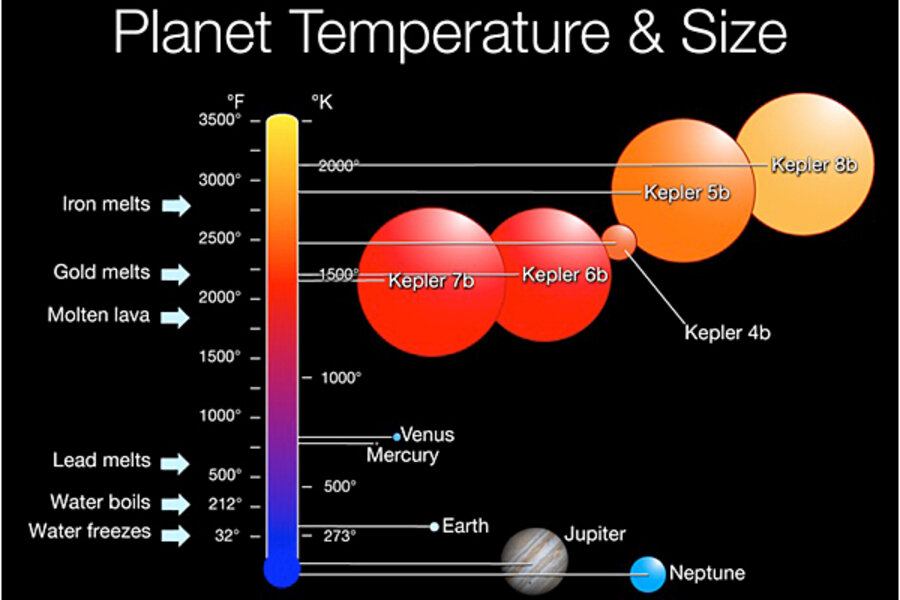NASA's Kepler finds its first five planets - an odd assortment
Loading...
NASA's planet-hunting telescope Kepler has bagged its first quarry: five new planets Neptune's size and larger, including one with the density of Styrofoam, making it one of the lightest planets yet found.
In addition to the new planets, Kepler results suggest that the light output from two-thirds of some 43,000 sun-like stars in its field of view is virtually as stable as the sun's output.
That seemingly obscure observation suggests that the majority of stars potentially are as hospitable to life as Earth's sun, assuming there was an Earth-like planet orbiting at the right distance from the star.
"If most stars are quiescent, that increases the havens for life in the universe," says astronomer Caty Pilachowski of Indiana University. The reason: Periodic strong outbursts of radiation from a star could sterilize a planet's surface, even if the planet orbited the star in the so-called habitable zone.
That zone represents distances where any water on a planet's surface would receive just enough heat to remain liquid and stable on the planet's surface.
Quiescent stars mean "we're more likely to have habitats where life can evolve and increases our chances of finding that life down the road," she says.
Planetary oddities
The results, released Monday during a briefing and talks at the winter meeting of the American Astronomical Society in Washington, involves planets whose radii range from a little over one-third to 1.6 times Jupiter's radius.
Several are oddities among the some 400 exoplanets – planets outside our solar system – astronomers have found so far. Kepler 7b, as one planet is known, is a lightweight, with Styrofoam-like density. Keplers 5b, 6b, and 8b all have densities lower than models predict for gas-giant planets. All are less dense than water.
The new planets are so close to their host stars that their orbits range from 3.2 to 4.9 days. That also means the planets endure searing temperatures – three are hotter than molten lava, and the two hottest would melt iron.
These are "no place to look for life," says William Borucki, a planet-hunter with NASA's Ames Research Center at Moffett Field, Calif., and the mission's lead scientist.
Filling in the blanks
Comparing these new finds to the hundreds of exoplanets found so far, Dr. Borucki notes that beyond our solar system, there appears to be a kind of planetary desert around other stars. So far, scientists have found comparatively few planets between about 9.3 million miles and about 93 million miles from host stars.
Until now, that range has been poorly charted. But Kepler is in a unique position to explore it. Kepler was launched last March on a three-year mission to hunt for Earth-like planets orbiting in the habitable zones of stars – a mission that lends itself not only to peering into that desert range, but also looking for planets smaller than gas giants.
"This is the area that we will be exploring and filling in in the coming years," he says.
But those discoveries will take far more time to make and confirm than the it takes to spot and confirm the oversize orbs announced Monday.
Overall, Kepler stares relentlessly at some 156,000 stars in one patch of the sky. Kepler discovered the planets as they slipped in front of their host stars with each orbit, briefly dimming the star's light, an astronomical movement called a transit. The bigger the planet, and the closer it orbits its parent star, the easier it is for Kepler to catch the brief fading and brightening of the star's light during a transit.
Initially, Kepler comes up with "candidates" that must be confirmed by astronomers using ground-based telescopes. And to keep false alarms at a minimum, Kepler scientists want to see four transits for each planet.
For Earth-sized planets, the periodic brightening and dimming gets increasingly harder to spot with stars that are farther away or that are inherently dim.
A curious candidate
Yet even "candidates" that turn out not to be exoplanets can yield their own discoveries. The team noted that it also discovered two objects, each orbiting its own large star. Yet each of the smaller objects was too hot to be a planet. Indeed, they outshone the stars they orbited. Yet the objects appeared to be too small to be another star.
The researchers suggested that these tiny orbiting torches could be low-mass white dwarfs in binary star systems. A white dwarf is the final stage in the demise of stars not massive enough to explode as supernovae. These stars shed most of their material in a nova, leaving behind what typically is an Earth-sized object with the sun's mass.
-----
Follow us on Twitter.





